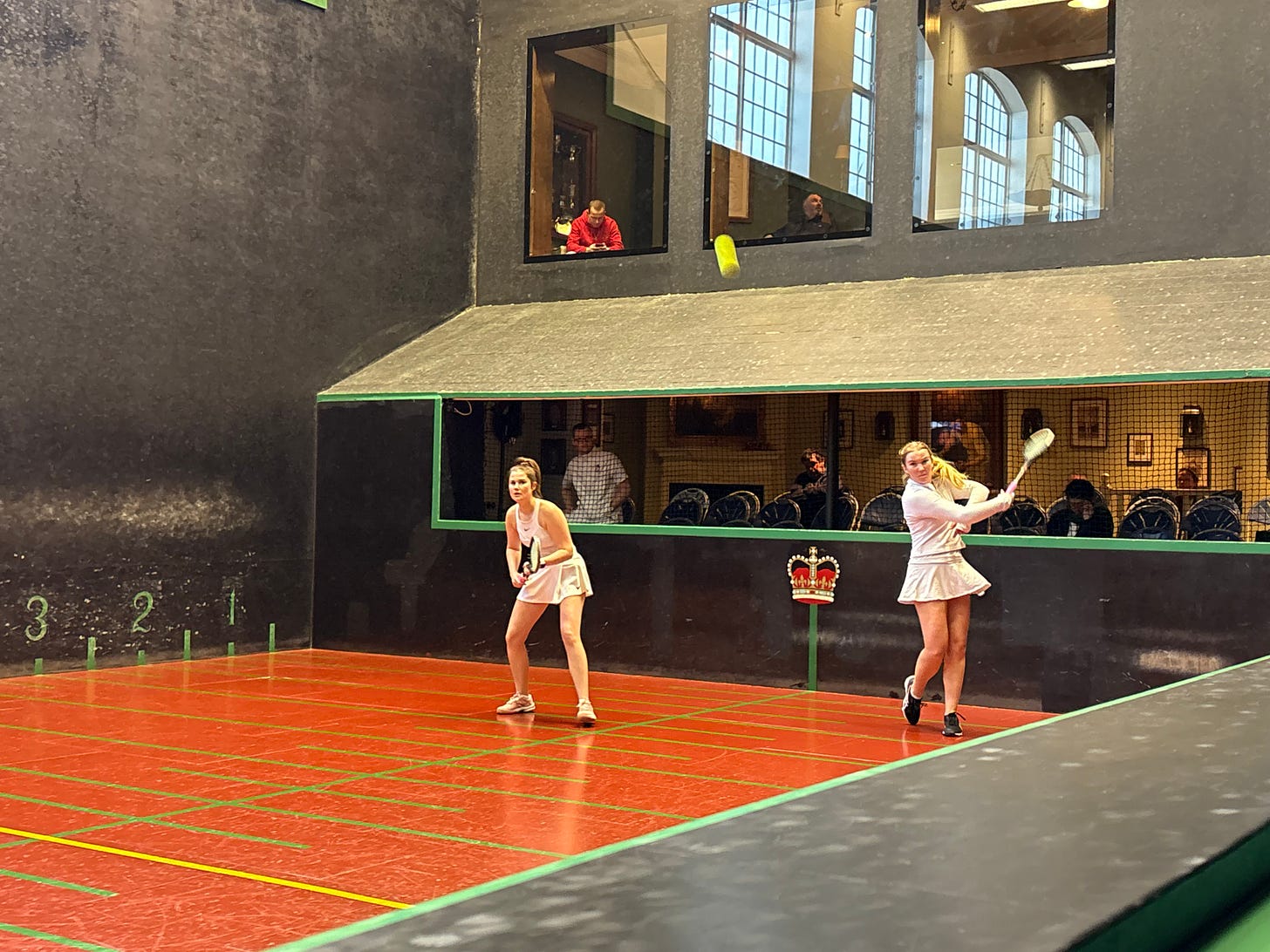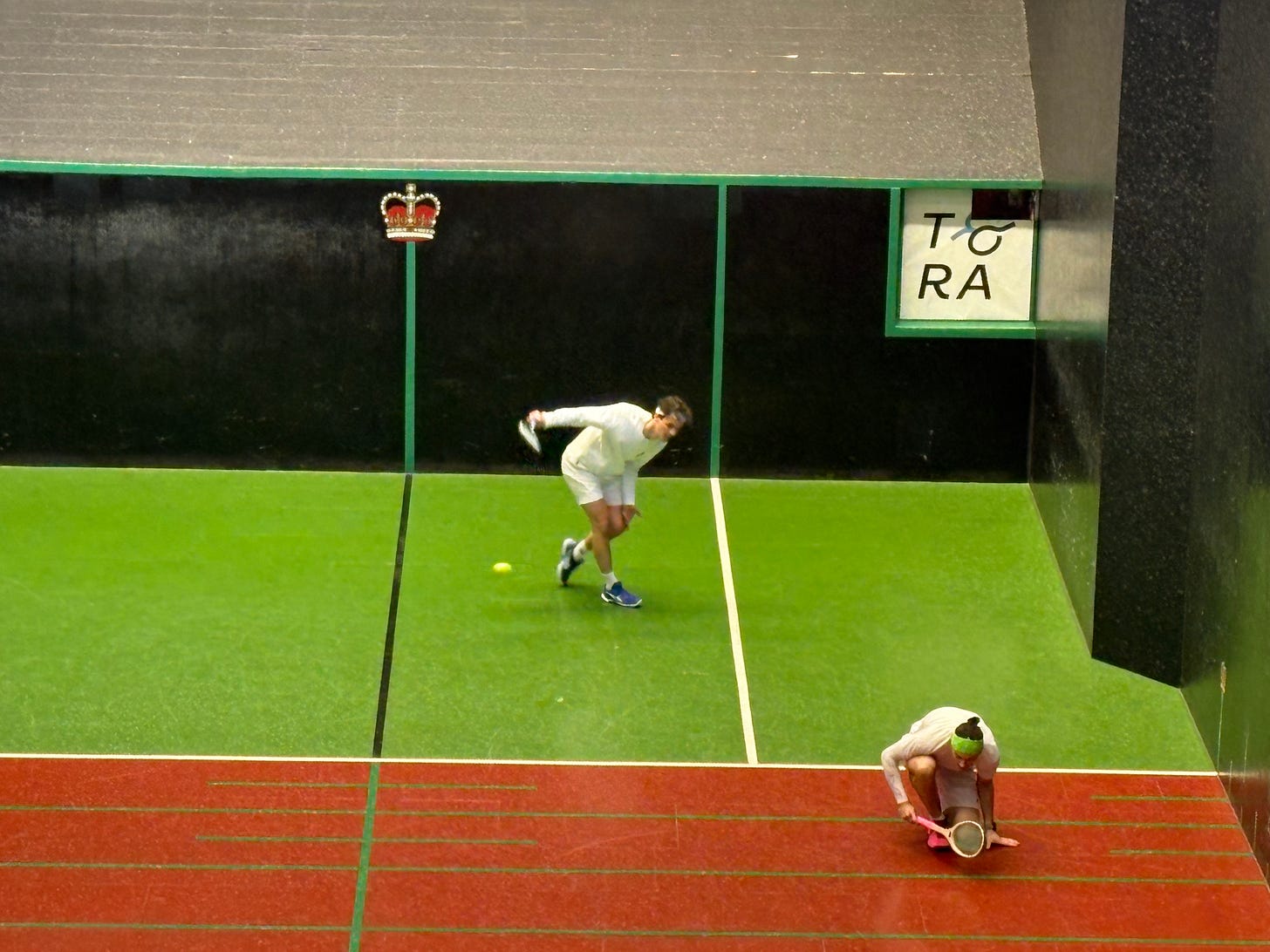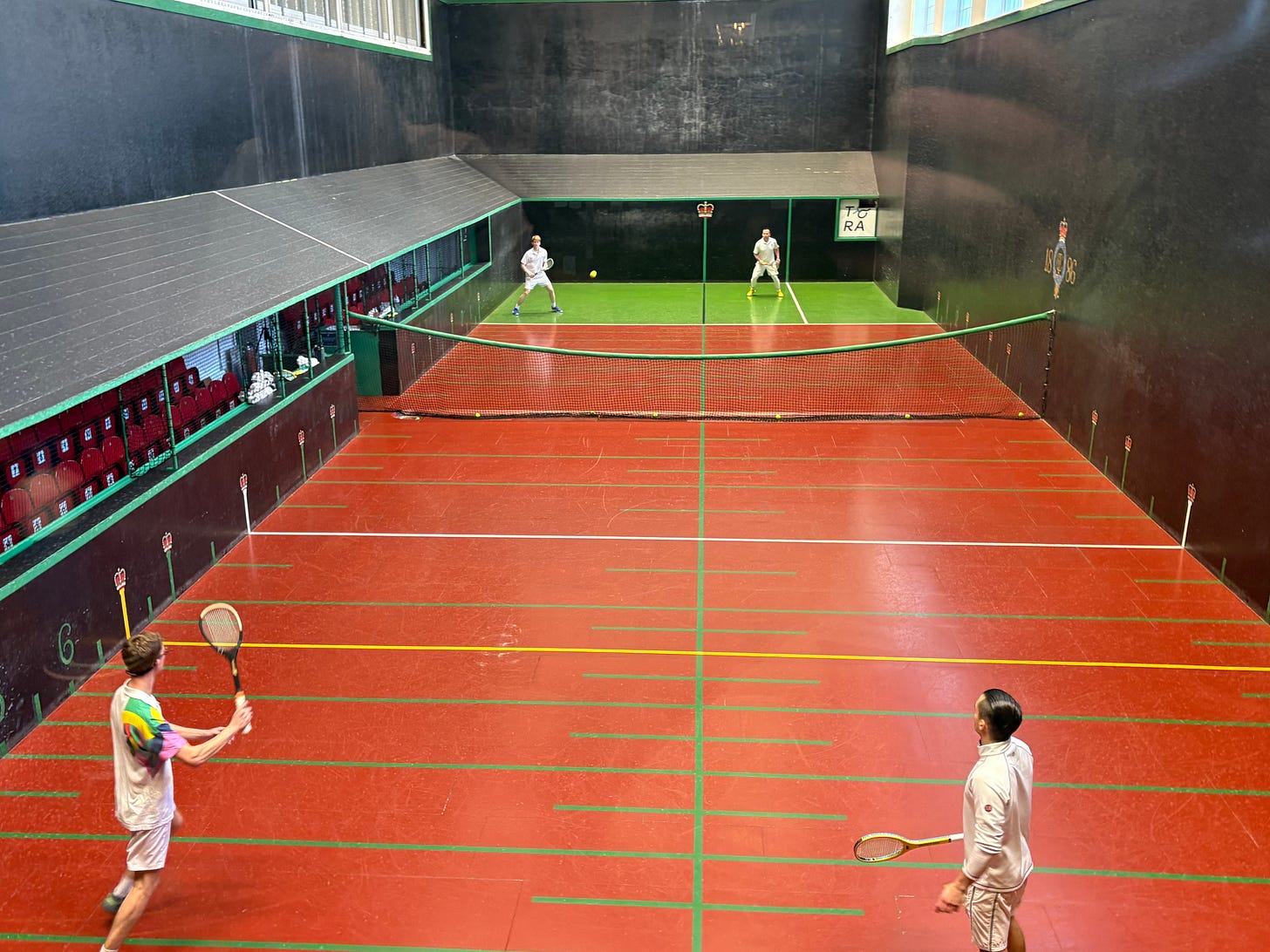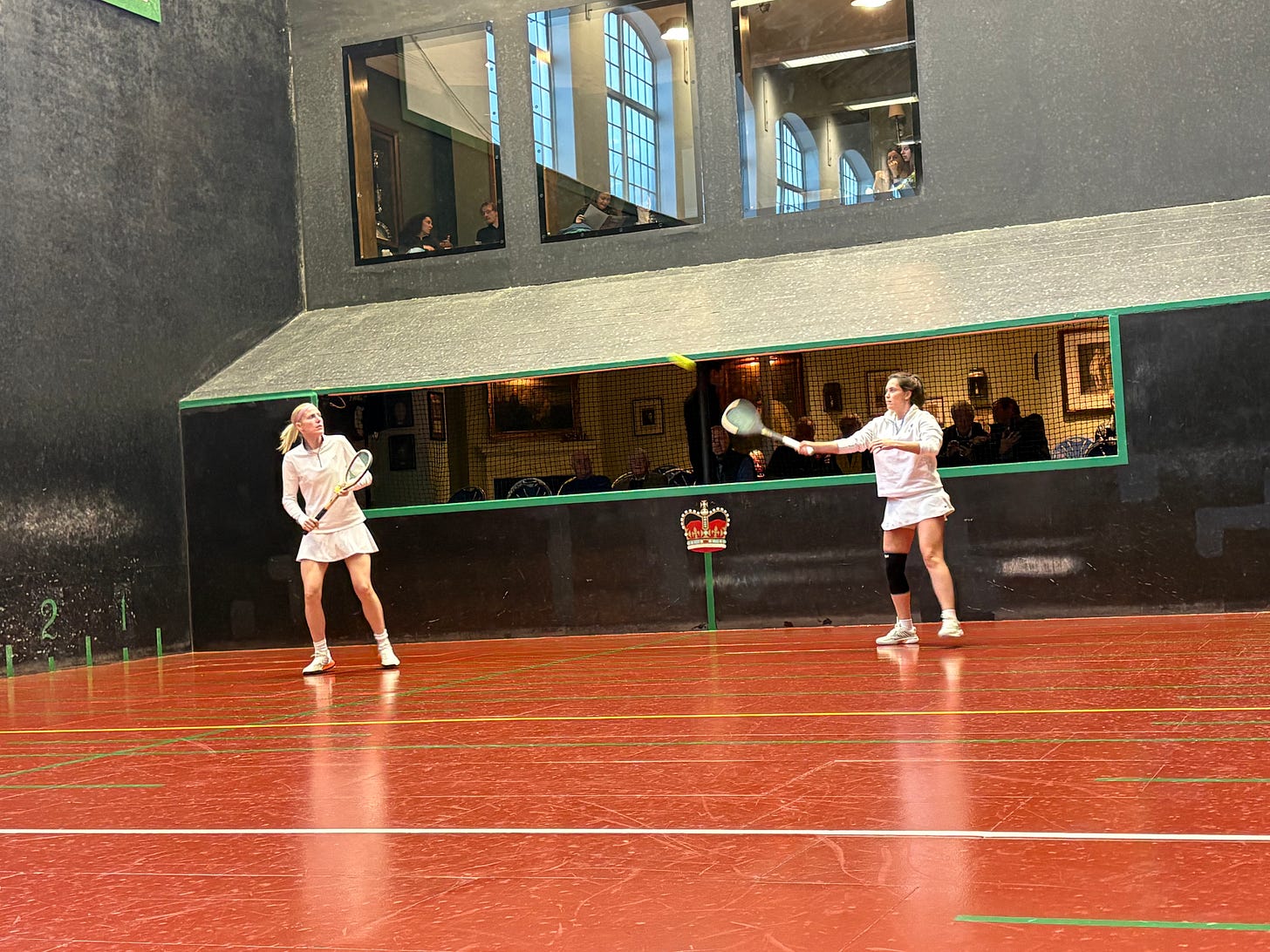Garside and Willis scrape through British Open semi-final in deciding game
Woods-Casey and Dodgson beat Shenkman and Smart in exhilarating four-setter; Sayers and Taylor-Matthews survive four-hour encounter over Gale and Williams
The first and last balls of the doubles matches at the British Open at Queen’s on Friday were separated by 13 hours, with the intervening time containing an exhilarating series of tennis matches, with some top seeded pairs completing narrow escapes and others being felled by lower-ranked yet equally capable opponents.
The day again commenced at the early time of 9:00 AM with start of the women’s doubles competitions. The small, four-pair draw meant the first match was the semi-final between the number two seeds, Georgie Willis and Jess Garside, against Araminta “Minty” Oldham and Alexandra Bryant. Garside set up at the galleries and Willis covered the back, while Bryant and Oldham — both fairly evenly balanced players — opted to play server up. Bryant was keen to take the game to the number two seeds, buoyed by running to a deciding set against Tara Lumley earlier in the week. She was finding good pace on the ball, coupled with excellent control, catching Willis out on the forehand corner. Meanwhile, Oldham rarely missed a volley. Willis was overhitting her shots, sending a lot of balls into the hazards off the back wall and their unforced errors were mounting up. Bryant and Oldham pushed on from 1-all to 5/1. This triggered a change in tactic from the second seeds, dropping Garside back to give Willis an easier time chasing balls into the forehand corner.
The second seeds opted to switch receivers into the second set, with Bryant serving to Garside. They then slowly seized the initiative in the match, winning the second game on the seventh deuce before marching off with the set, despite Bryant and Oldham winning some late games. A long tactical discussion from both pairs preceeded the start of the third set, with Bryant and Oldham opting to return to the receiving setup from the first set. Their tactic paid off, at least initially, winning the first two games of the set, but Garside and Willis had the quality to bring the score back to 2-all. The set was nervy thereafter, with each of the four feeling the tension. Bryant and Oldham held the service end for a few games as chases were a rare commodity, pulling the score towards a 5/4 lead. The best reste of the match came at the end of the next game, with a nervy Bryant and Oldham fighting desparately to stay alive while Willis and Garside peppered them with balls onto the tambour. The number two seeds forced the game into a decider, which they started from the service end. The latter fact was key, as Willis found several grilles in the last game to secure their place in the final by the skin of their teeth.
The open doubles quarter-finals then began, with a match between the fourth seeds Robert Shenkman and Leon Smart, and the sixth seeds Josh Dodgson and John Woods-Casey. Even though Shenkman and Smart were superior in world ranking points, the RealTennisOnline doubles calculator suggested just a single handicap point difference between the pairs. A tight match beckoned. In the event, Dodgson and Woods-Casey raced away to a big lead, with very positive, aggressive play while plenty of unforced errors came from the other side of the net. After a few games, Dodgson and Woods-Casey experimented by putting Dodgson forward instead of Woods-Casey, just to mix things up. The New York professional was excellent at picking out volleys both from the galleries and in front of the tambour, generating great angles and snatching balls from nowhere. From the hazard end, Dodgson was also able to float several balls into the dedans, dipping late. Woods-Casey was able to match his partner shot for shot, combining to excellent effect. They also raked in the winning galleries, each one finding a very different route towards the bells. Shenkman and Smart never got out of first gear across the first nor second sets. By set point in the second, Shenkman shaped up to deliberately concede the set, having gone twenty points without earning a chase. Recognising this, Dodgson stepped up to serve a pound serve, but hit it so well that the ball came out for a fault off the high back wall.
Shenkman and Smart did earn their partner switch for the third, with Smart now serving to Dodgson. Instead of turning the match around, Dodgson and Woods-Casey only got stronger, their volleys more insane and their quick-reflex shots more impressive. However, Smart finally gained a foothold in the match by tying Dodgson down with his full pique serve. To try and counter Shenkman and Smart’s newfound lead on the scoreboard, Dodgson was pushing higher and higher on the court, until he was taking volleys while standing with a foot in the gutter in the center of the court. While impressive and elliciting gasps from the audience, it didn’t stop Shenkman and Smart extending a 5/2 lead in the third set. A game later, they were able to take the set, though were forced to accept being at the service end in the process.
There was a slight confusion at the start of the fourth set as Shenkman was not sure who was set up to receive — given that through the previous set, the receiver had set up on the grille side to receive the pique. After a moment, Woods-Casey nominated to switch back to Smart’s serve, as had been the case through the first two sets. The tennis was the closest of the match, with Woods-Casey and Dodgson having to pare back their extravagant shot-making and instead knuckle down to some hard graft. There was some minor controversy in the fifth game when playing off chase the door, as Smart’s shot hit the door post just as Dodgson’s foot and racket disturbed the net. With fractions of a second in it, the marker called chase-off, despite protestations from Smart. Dodgson and Woods-Casey went on to win the next two games but, in part due to Shenkman’s good high serving, as well as Smart becoming more active on the backhand at the galleries, the number four seeds won the next three games to 5/4. Woods-Casey narrowly missed a winning gallery to send the game into a decider but Dodgson instead rolled in two main wall dedans a few moments later. Shenkman and Smart went 30-0 up on the back of a pair of unforced error, but a dedan boasted off the tambour wall and a couple of volley errors from Shenkman brought up match point with a worse than second gallery chase. Woods-Casey’s railroad was milimeter perfect, with Smart only able to spoon the ball onto the penthouse. Woods-Casey slammed the ball into the tambour, winning the match and immediately embracing his partner. The winners stayed on court after the match to sign autographs for the local schoolchildren who had been watching in the side gallery, before both heading to rebook their flights as they extend their stay in London and with Dodgson donning his tuxedo to head to a wedding.
Running an hour over schedule, the next match was the first glimpse at a rare sight in real tennis, that of a top-ranked player partnering with a rising star as John Lumley took to their court with Vaughan Hamilton. On the opposite side of the net was Darren Long and Bertie Vallat. Despite the unconventional setup, Lumley and Hamilton quickly established themselves as the dominant pair on the court. Hamilton smoothly slotted into his role as the gallery player, not at all looking uncomfortable stepping onto the bigger stage. His hands were quick and finishes strong, meaning Lumley could relax into his role as the stable partner. They led both the first and second sets from start to finish — including taking the second in just 14 minutes and conceding just 9 points. They then elected to switch receivers for the third set, playing out the rest of the match with an exhibition flair, bringing the match to a close well inside an hour.
With the matches now back on schedule, the second women’s doubles semi-final took place, with World Champions Claire Fahey and Tara Lumley being challenged by Nicola Doble and Alex Brodie — both of whom had previously partnered Fahey in Opens. Fahey largely took a back seat through most of the first set, giving Lumley the responsibility of hitting most of the big winners. It was a role she adapted to well, challenging Doble on her left-handed backhand. Though perhaps not reflected in the scoreline, Doble and Brodie took the fight to Fahey and Lumley. Few points were gimmes, with the World Champions having to battle to win the rallies. But while it proved an entertaining spectacle, the scoreboard never provided pressure as the first seeds easily secured progression to the final.
The open doubles resumed with the first seeds in that draw, Robert Fahey and Nick Howell, being challenged by the qualifiers James Medlow and Ned Batstone. Fahey sent Howell to the back of the court. It was easy going for the two Australians, as the two young Englishmen struggled to defend against the quality of ball sent their way. The first four games sailed by, and though the last two games of the first set featured several long deuce battles, Batstone and Medlow were not able to convert them into any games on the scoreboard — despite registering a respectable set of totals on the end of set stat card. The second set stat card was much less heartening reading for Batstone and Medlow, winning just nine points in 15 minutes of play. By the third set, Fahey and Howell were on cruise control, finding it straightforward no matter how hard Batstone and Medlow tried. On match point, Fahey attempted to play a shot off the net cord into the winning gallery with both feet off the ground, but missed. Howell showed Fahey how it is done on the next ball, tickling a backhand into the same gallery, marking the first triple-bagel of the week.
After an hour break which included an on-court demonstration for the local school kids in attendance, the final quarter-final got underway with two pairs that had each knocked their partner out of the singles. Third seeds Bryn Sayers and Ben Taylor-Matthews played fifth seeds Levi Gale and Lewis Williams. Gale and Williams approached the match with a serving theory of sending in an unlimited supply of pique serves, attempting to push the receiver as close to the service line as possible. Sayers and Taylor-Matthews stuck predominantly with high serves throughout, much to the same end. The rallies that followed were long and brutal, with none of the four players on court able to find an exit for the reste, none of them willing to give up on any ball and none of them making many errors. The resulting rally would therefore either need somebody to make a rare error, or for a long ball to be hit for a hazard or long chase. Even receiving the ball on the penthouse was no guarantee of finishing the rally, as the retrieval on display was good enough to cope with whatever ball came next. Just about every game came with long deuce battles, and though every rally was an event neither pair could get any long runs of points, let alone games.
The first set took over 50 minutes to complete, as did the second. The first saw no breaks of more than a game, but in the second, Gale and Williams were able to, albeit slowly, string some games together. Both gallery players — Williams and Sayers respectively — were playing very deep, locking down the defensive options but giving themselves limited attacking ones. Gale’s movement up the main wall on the service side particularly impressed, able to step in and cut off any cross court boasts coming his way. They won a stretch of five out of six games to take the lead in the second set, evening the score at 1-all.
Sayers and Taylor-Matthews switched receivers for the third set, though as the serves had been so monotonous for over two hours it took a few points for the players and marker to realise they had accidentally switched back again. With Sayers’s high serve now pinning down Williams’s cut volley, the second seeds broke out to a narrow lead in the third set which, through much grinding and effort, they held on to throughout. Gale switched back to Sayers’s serve for the fourth, with the balance of the play once again tilting marginally in their favour. They clawed back from 2/4 down to taking the set 6/4 and forcing a decider.
By the fifth set, little had tactically changed from the first: Gale and Williams still serving piques and both sides battling it out up and down the main wall. Williams was holding a higher position by now, which came with the benefit of taking time out of his opponents but the drawback of putting more balls onto the penthouse. From 3-all in the final set, Sayers and Taylor-Matthews edged ahead by two games, but the fight never abandoned Gale and Williams. They successfully brought back one game of the deficit, but lost the serve at the start of the next game. Consequently, Sayers and Taylor-Matthews brought up their first match point. Gale and Williams fought desperately and heroically to defend it as Sayers and Taylor-Matthews zeroed in on the kill, the result ending in a worse than last chase. On the change of ends, Taylor-Matthews put a volley underneath the last gallery, finally putting to an end the four-hour epic.
Play continues on Saturday with the two open singles semi-finals, followed by the women’s singles final. The doubles action will resume on Sunday with the two open doubles semi-finals and the women’s doubles final.
Match results:
9:00 AM: Alexandra Bryant & Araminta Oldham lost to Jess Garside & Georgie Willis (2) 6/3 3/6 5/6
10:30 AM: Robert Shenkman & Leon Smart (4) lost to Josh Dodgson & John Woods-Casey (6) 1/6 1/6 6/3 5/6
12:30 PM: Darren Long & Bertie Vallat lost to Vaughan Hamilton & John Lumley (2) 3/6 1/6 1/6
2:30 PM: Claire Fahey & Tara Lumley (1) def Alex Brodie & Nicola Doble 6/1 6/0
4:00 PM: Robert Fahey & Nick Howell (1) def Ned Batstone & James Medlow 6/0 6/0 6/0
6:00 PM: Levi Gale & Lewis Williams (5) lost to Bryn Sayers & Ben Taylor-Matthews (3) 5/6 6/4 3/6 6/4 4/6
Order of play for Saturday (all times GMT)
2:00 PM: Robert Fahey (4) vs Nick Howell (2)
Followed by (approx 4:00 PM): John Lumley (1) vs Bryn Sayers (7)
Not before 6:45 PM: Claire Fahey (1) vs Tara Lumley (2)








